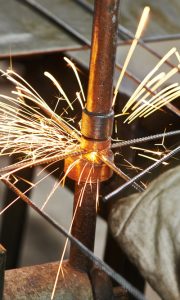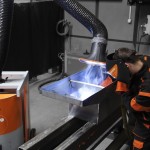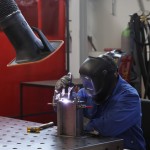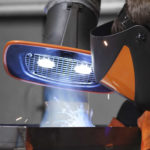Resistance welding: Risk from magnetic fields with little welding fumes
Welding fumes are not the greatest risk from resistance welding. Magnetic currents created by the welding process pose a far greater threat to the health of employees. Use of suction and filtering technology is therefore advisable, at least with a ventilation system. Welding oiled panels causes greater amounts of smoke.
Resistance welding is possible, then, when materials are conductive. This is the rule [of thumb] for welding. Welders initiate this feature particularly when joining thin panels, such as in automotive assembly, or when welding together bolts and nuts to steel parts. The parts to be joined are selectively heated via a high current density at a certain point until they reach welding temperature. They are then joined with high strength (resistance pressure welding) or in some cases with filler material (resistance fusion welding). In the first case, a distinction is made between resistance spot welding, resistance projection welding, resistance stud welding, resistance seam welding, and resistance butt welding.
Wearing personal protective equipment is important
The processes differentiate themselves in regard to type of joint and amount of current used. The low voltage used in the welding process, however, is common to all of them. Health risks do not arise from them. Occupational safety for resistance welding arises from another background:
- Weld spatter from the welding point can cause burns – these are not electrical sparks but rather molten welding material.
- Due to the excessive force used in resistance welding, welders can inflict bruises on themselves if they are careless near the electrodes.
- Use of the electrodes causes the noise level to increase rapidly.
- After removing the welding inverter from the power source, the circuit still retains voltage that is dangerous to touch. The discharge time may take several minutes, depending on the type and model.
- If welders open the welding equipment for capacitor pulse welding, , there is a risk of fatal electric shock – if the capacitors were not discharged or only partially discharged by the welding process. This danger can exist even if the welding device is switched off.
 This hazard is the reason for personal protective equipment or proceeding with caution. Wearing respiratory, eye, ear and hand protection is recommended.
This hazard is the reason for personal protective equipment or proceeding with caution. Wearing respiratory, eye, ear and hand protection is recommended.
Proper labelling is compulsory; air purification is advisable
But this is not enough: Strong magnetic fields around resistance welding equipment develop during welding. This is especially relevant for those who have pacemakers. Implanted devices can be disrupted by the magnetic fields. The risk situation must be assessed by an authorised person. Furthermore, affected areas must be labelled throughout the plant and must be secured so that persons cannot gain access, enter, or remain in the area during operation.
But this is not enough: Air purification also plays a role during resistance welding. During welding or spattering, certain amounts of welding fumes develop in the form of metal oxides. Under normal conditions, this amount usually falls under the acceptable limit. This, however, can change if welders are working with oiled or greased panels. Such surfaces cause greater amounts of welding fumes to develop that also contain organic compounds. For example, during spatter-free welding, there is 30 percent more hazardous material created with greased panels than with ungreased panels. Moreover, with flash butt welding, greater amounts of welding fumes develop compared to other resistance welding processes. As a rule, suction is required directly at the machine.
Welding spatter is also not hazard- free from the standpoint of welding fumes. They generally draw a small welding smoke trail behind them. Point suction, however, is difficult due to their unpredictable movements. For this reason, a room ventilation system that can capture ascending hazardous materials is advisable.





